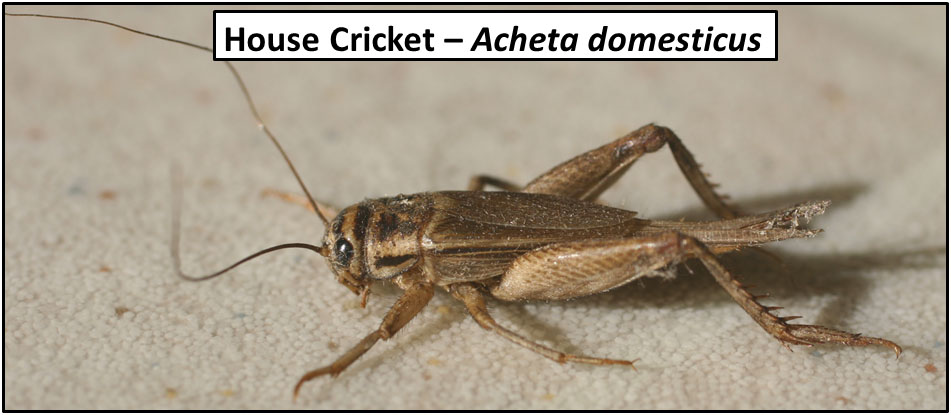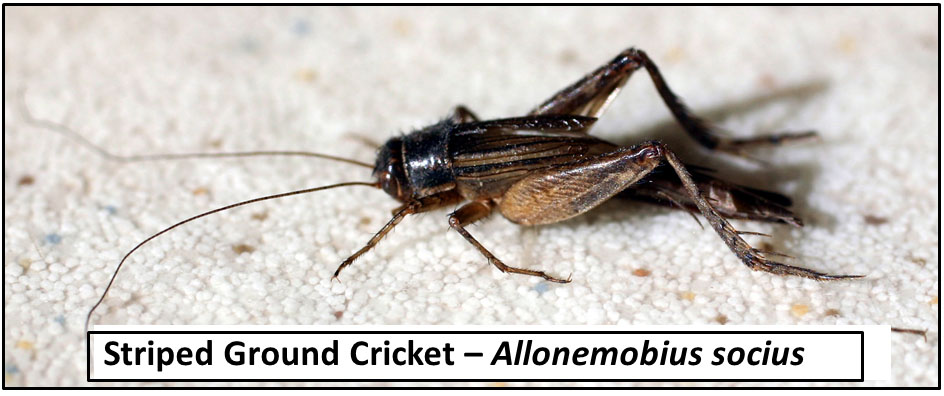–by Dr. Bob Bauernfeind
While I certainly do not want to create any hysteria as did Henny Penny when she ran around the town shouting, “The sky is falling. The sky is falling”, it may be that we are in store for impending cricket invasions, at least based upon what I am currently seeing (for the first time ever that I can recall) in-and-around my yard and home: crickets, crickets and more crickets. Actually thinking back earlier this year, I recall saying to myself, “Huh, look at these little crickets!” While I cannot account for their observed numbers (no official counts per se), perhaps this year’s adequate moisture may have been favorable for their survival and development.
Crickets subsist on a wide range of food sources. As generalist omnivores, they are opportunistic feeders deriving nourishment wherever on whatever is available including plant, dead organic plant and animal matter, algal, fungal and bacterial sources.
The mere presence of crickets can be annoying. In addition, while the chirping of male insects may be considered beautiful music-in-the-night out-of-doors, indoors it may be regarded as noisy and disruptive. Although not bona fide fabric pests, being what they are (insects with chewing mouthparts) and doing what many insects do (test/taste-their-surroundings), crickets may be responsible for creating holes in and leaving stains on light-colored fabrics (curtains/sheers the oft-cited areas showing damage).
When people think about crickets in the home, logically the name house crickets comes to mind. And there are crickets officially called “house crickets”. House crickets are brown in color and about an inch in length. Whereas they naturally occur in the warmer climates of southwestern Asia, they have no special overwintering stage as would be required for surviving winters in temperate regions where they are commercially reared and marketed as food for amphibians, birds, reptiles and other arthropods. While they now have become established worldwide, survival of escaped adults is minimal (but possible) in and around heated areas. It is unlikely that “house crickets” will be paying you a visit.
Rather, the crickets which enter homes will likely be “field crickets”. Mature field crickets approach an inch in length. The female, is easily identifiable by the presence of her prominent ovipositor measuring another ¾-inch. Most field crickets are all black in color, but some may have a lighter appearance due to their coppery-colored wings.
A third type of cricket is a smaller-in-size “ground cricket” commonly called the striped ground cricket. These are the small “summer crickets” that occasionally are attracted to commercial districts and businesses illuminated by high intensity lighting which acts as a beacon to these crickets capable of flying to the distant glow of city lights and business-lit areas. Their life cycle differs in that they attain adulthood during mid-late summer. Eggs are already deposited and most adults died before the onset of cooler fall weather.
With regard to seasonal life history, field crickets overwinter as eggs deposited in the soil. Currently, field crickets are now in their mid-development stages, and for the most part go unnoticed. By the time cooler fall weather moves in, field crickets will have reached their adult stages. Before and after mating and depositing eggs, crickets move towards sources of heat such as homes and buildings whose exteriors “soak up” the sunlight/heat. Crickets are capable of detecting heat gradients and thus are drawn in. Once on-the-doorstep, they are a hop away from secretly moving in through any available crack/crevice/opening.
How does one go about attempting to prevent cricket “visitors” in homes and possibly business establishments? The first thought might be the outdoors use of insecticides to kill crickets. When cricket populations are large and there is the likelihood of impending invasions, reduction of their numbers may be achieved with insecticide applications as barrier treatments applied to a 6- to12-foot band around the perimeters of homes and businesses. Once inside, insecticides registered for indoor use against crickets or (in general) indoor invasive species can be applied per labeled instructions. Indoor applications may be general surface, spot, mist or crack and crevice treatments.
According to NPIRS (National Pesticide Information Retrieval System, currently in Kansas, individually clicking onto striped ground crickets, house crickets, field crickets and crickets, there are 4, 44, 84, 1392 products, respectively. Collectively clicking onto all of the mentioned categories, there are 1,410 products. So there are plenty of insecticide options. However, even if a person sprays, sprays, sprays outdoor areas until they glow that does not guarantee against eliminating all potential invaders.
Perhaps a more successful approach for preventing cricket “guests” is to EXCLUDE THEM! Again, as previously mentioned, crickets (as well as any other commonly named “fall guests” such as boxelder bugs, elm leaf beetles, multicolored Asian lady beetles, spiders) gain entrance via any available crack/crevice/hole/gap. Thus sealing these portals of entry is a recommended method of exclusion. Attempt to insect-proof houses and buildings by thoroughly inspecting and identifying entry points. Check for cracks and gaps in structure foundations, ill-fitting doorways and garage doors, overhang louvers, chimney vents, roof ducts, soffits, air conditioner connections, outdoor faucets and siding. Use caulk to seal cracks and crevices, weather stripping to make doorways and garage doors tightfitting, and metal screening over/under/behind other entry points. Such simple words. Yet, in all practicality when looking at my home (which I consider sound-and-sealed), I know that there are (still remaining) untended access points. I expect that like many other people, I will have “fall visitors”. Sort of a fact-of-life that one must accept.


